SIU Director’s Report - Case # 18-OVI-023
Warning:
This page contains graphic content that can shock, offend and upset.
Contents:
Mandate of the SIU
The Special Investigations Unit is a civilian law enforcement agency that investigates incidents involving police officers where there has been death, serious injury or allegations of sexual assault. The Unit’s jurisdiction covers more than 50 municipal, regional and provincial police services across Ontario.
Under the Police Services Act, the Director of the SIU must determine based on the evidence gathered in an investigation whether an officer has committed a criminal offence in connection with the incident under investigation. If, after an investigation, there are reasonable grounds to believe that an offence was committed, the Director has the authority to lay a criminal charge against the officer. Alternatively, in all cases where no reasonable grounds exist, the Director does not lay criminal charges but files a report with the Attorney General communicating the results of an investigation.
Under the Police Services Act, the Director of the SIU must determine based on the evidence gathered in an investigation whether an officer has committed a criminal offence in connection with the incident under investigation. If, after an investigation, there are reasonable grounds to believe that an offence was committed, the Director has the authority to lay a criminal charge against the officer. Alternatively, in all cases where no reasonable grounds exist, the Director does not lay criminal charges but files a report with the Attorney General communicating the results of an investigation.
Information restrictions
Freedom of Information and Protection of Privacy Act (“FIPPA”)
Pursuant to section 14 of FIPPA (i.e., law enforcement), certain information may not be included in this report. This information may include, but is not limited to, the following:- Confidential investigative techniques and procedures used by law enforcement agencies; and
- Information whose release could reasonably be expected to interfere with a law enforcement matter or an investigation undertaken with a view to a law enforcement proceeding.
- Subject Officer name(s);
- Witness Officer name(s);
- Civilian Witness name(s);
- Location information;
- Witness statements and evidence gathered in the course of the investigation provided to the SIU in confidence; and
- Other identifiers which are likely to reveal personal information about individuals involved in the investigation.
Personal Health Information Protection Act, 2004 (“PHIPA”)
Pursuant to PHIPA, any information related to the personal health of identifiable individuals is not included. Other proceedings, processes, and investigations
Information may have also been excluded from this report because its release could undermine the integrity of other proceedings involving the same incident, such as criminal proceedings, coroner’s inquests, other public proceedings and/or other law enforcement investigations.Mandate engaged
The Unit’s investigative jurisdiction is limited to those incidents where there is a serious injury (including sexual assault allegations) or death in cases involving the police.
“Serious injuries” shall include those that are likely to interfere with the health or comfort of the victim and are more than merely transient or trifling in nature and will include serious injury resulting from sexual assault. “Serious Injury” shall initially be presumed when the victim is admitted to hospital, suffers a fracture to a limb, rib or vertebrae or to the skull, suffers burns to a major portion of the body or loses any portion of the body or suffers loss of vision or hearing, or alleges sexual assault. Where a prolonged delay is likely before the seriousness of the injury can be assessed, the Unit should be notified so that it can monitor the situation and decide on the extent of its involvement.
This report relates to the SIU’s investigation into the serious injuries sustained by a 22-year-old female, Complainant #1, and a 21-year-old female, Complainant #2, during an attempted vehicle stop by the police on January 31, 2018.
“Serious injuries” shall include those that are likely to interfere with the health or comfort of the victim and are more than merely transient or trifling in nature and will include serious injury resulting from sexual assault. “Serious Injury” shall initially be presumed when the victim is admitted to hospital, suffers a fracture to a limb, rib or vertebrae or to the skull, suffers burns to a major portion of the body or loses any portion of the body or suffers loss of vision or hearing, or alleges sexual assault. Where a prolonged delay is likely before the seriousness of the injury can be assessed, the Unit should be notified so that it can monitor the situation and decide on the extent of its involvement.
This report relates to the SIU’s investigation into the serious injuries sustained by a 22-year-old female, Complainant #1, and a 21-year-old female, Complainant #2, during an attempted vehicle stop by the police on January 31, 2018.
The Investigation
Notification of the SIU
At approximately 4:10 a.m. on January 31, 2018, the Stratford Police Service (SPS) reported that earlier on that date, at about 3:00 a.m., a police officer attempted to stop a vehicle at the intersection of Norfolk Street and Taylor Street, in the City of Stratford. The vehicle drove away and collided with a tree in the area of the intersection.The driver ran away from the scene and three passengers remained. The passengers were taken to hospital. Complainant #2 was diagnosed with a compound fracture to her ankle and Complainant #1 complained of back pain.
The Team
Number of SIU Investigators assigned: 3 Number of SIU Forensic Investigators assigned: 2
Three investigators and two forensic investigators (FIs) were dispatched to the collision scene. No civilian witnesses came forward to indicate that they had seen anything. A canvass of the houses with an immediate view of the intersection was conducted and resulted in various persons indicating that they had heard a bang, but had not seen the collision or what preceded it. No external cameras were seen on the houses near the site of the incident.
FIs photographed the scene and a scene drawing was prepared using the Total Station. Both the SO’s police vehicle and the Jeep Compass in which the Complainants had been passengers were examined for any evidence of contact between the two vehicles, with none being found.
The fourth occupant of the motor vehicle was said to have sustained a chipped tooth in the collision, but had left the hospital before investigators could speak with him. SIU investigators attended his residence to attempt to make contact, but no one was home. A business card was left for him to contact the SIU, but he did not do so.
Complainants
Complainant #1 22-year-old female interviewed, medical records obtained and reviewed Complainant #2 21-year-old female interviewed, medical records obtained and reviewed
Civilian Witnesses
CW #1 Interviewed Witness Officers
WO #1 Interviewed, notes received and reviewed Subject Officers
The SO Interviewed, notes received and reviewed Incident Narrative
During the early hours of January 31, 2018, the SO was notified by another SPS officer that a man, known to them to be on a court imposed curfew, might be breaching his conditions, as the officer had seen a white Cadillac that was associated with this party, on Romeo Street in the City of Stratford.
The SO made his way to Romeo Street but did not see the white Cadillac. The SO did, however, see a motor vehicle, a Jeep Compass, driving southbound without working taillights. The SO tried to catch up to the Jeep to advise the driver to put his lights on. The vehicle then turned right onto Norfolk Street and the SO again attempted to catch up to the vehicle. When the SO reached the intersection of Norfolk and Laurier Streets, he activated his emergency lighting in order to perform a vehicle stop.
Instead of stopping, however, the Jeep Compass accelerated and fled. It was cold out and the road conditions were icy. The Jeep attempted a left turn at the next street, Taylor Street, but failed to negotiate the turn, mounted the sidewalk, and struck a tree. The driver then fled the collision scene on foot, leaving behind his three passengers, each of whom was transported to hospital to be assessed.
Nature of Injuries/Treatment
Complainant #2 sustained a fracture involving the medial base of the left talus (the lower part of the ankle joint). It was discovered that there was anterior dislocation of the tibiotalar joint (the joint between the leg (tibia) and the ankle (talus)) with widening of the ankle mortise posteriorly (the bony arch formed by the tibia and fibula). The left ankle was placed in a cast.
Complainant #2 also sustained an oblique mildly comminuted fracture through the distal shaft of the tibia of the right ankle.
Complainant #1 underwent a CT scan at hospital which revealed a wedge shaped area of differential enhancement with the right kidney. In context of trauma, this was interpreted as possibly representing contusions or ischemia.
The third passenger left hospital before speaking with investigators and did not consent to release his medical records, and therefore his injuries remain unconfirmed.
The SO made his way to Romeo Street but did not see the white Cadillac. The SO did, however, see a motor vehicle, a Jeep Compass, driving southbound without working taillights. The SO tried to catch up to the Jeep to advise the driver to put his lights on. The vehicle then turned right onto Norfolk Street and the SO again attempted to catch up to the vehicle. When the SO reached the intersection of Norfolk and Laurier Streets, he activated his emergency lighting in order to perform a vehicle stop.
Instead of stopping, however, the Jeep Compass accelerated and fled. It was cold out and the road conditions were icy. The Jeep attempted a left turn at the next street, Taylor Street, but failed to negotiate the turn, mounted the sidewalk, and struck a tree. The driver then fled the collision scene on foot, leaving behind his three passengers, each of whom was transported to hospital to be assessed.
Nature of Injuries/Treatment
Complainant #2 sustained a fracture involving the medial base of the left talus (the lower part of the ankle joint). It was discovered that there was anterior dislocation of the tibiotalar joint (the joint between the leg (tibia) and the ankle (talus)) with widening of the ankle mortise posteriorly (the bony arch formed by the tibia and fibula). The left ankle was placed in a cast.Complainant #2 also sustained an oblique mildly comminuted fracture through the distal shaft of the tibia of the right ankle.
Complainant #1 underwent a CT scan at hospital which revealed a wedge shaped area of differential enhancement with the right kidney. In context of trauma, this was interpreted as possibly representing contusions or ischemia.
The third passenger left hospital before speaking with investigators and did not consent to release his medical records, and therefore his injuries remain unconfirmed.
Evidence
The Scene
The scene of the motor vehicle collision was in the area of the intersection of Norfolk Street and Taylor Street in the City of Stratford, with the Jeep coming into contact with a tree on Taylor Street in front of the residence on the corner. 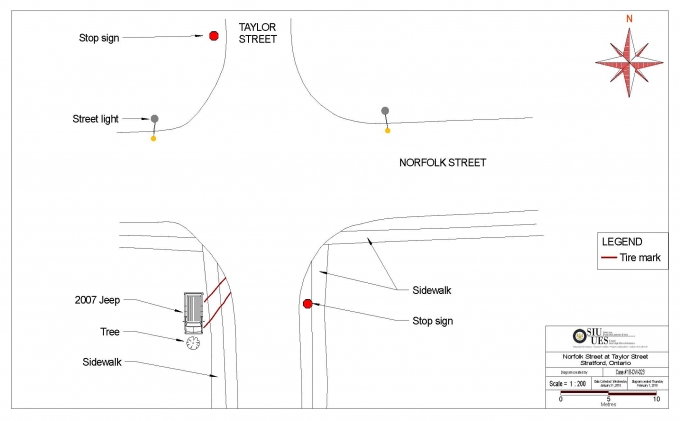
The Jeep Compass is seen to the left of the photo, in contact with the tree.
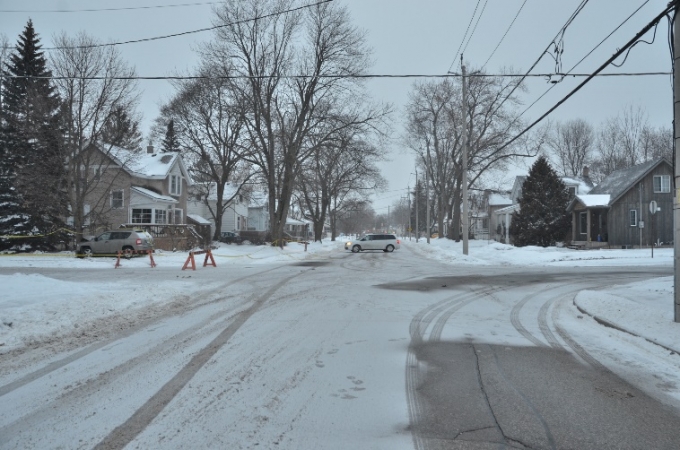
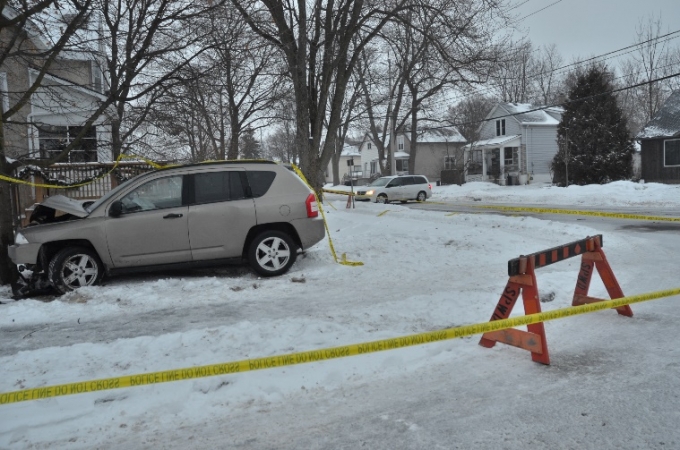
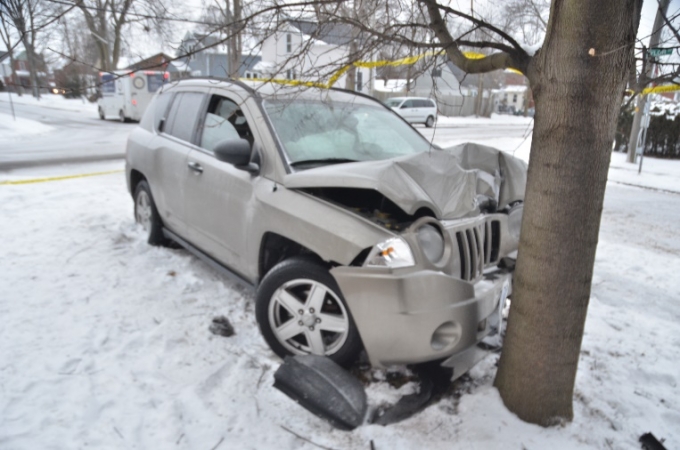
Physical Evidence
GPS Data for the SO’s Police Vehicle
From point 26, travelling southbound on Romeo Street South, turning right onto Norfolk Street and proceeding westbound on Norfolk Street to point 34 just past Borden Street.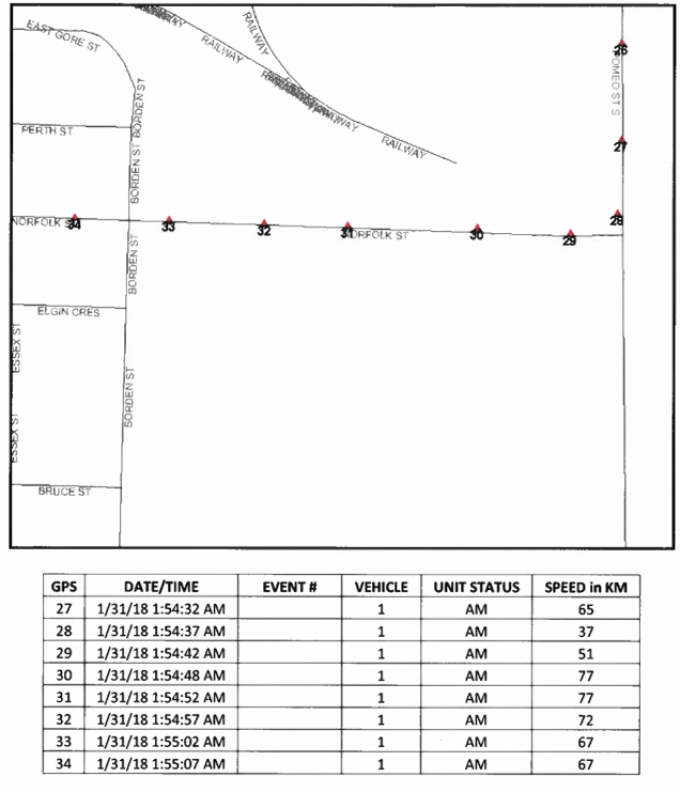
From point 33 travelling westbound on Norfolk Street and approaching the final resting place of the Jeep Compass at point 40 just south of the intersection on Taylor Street.
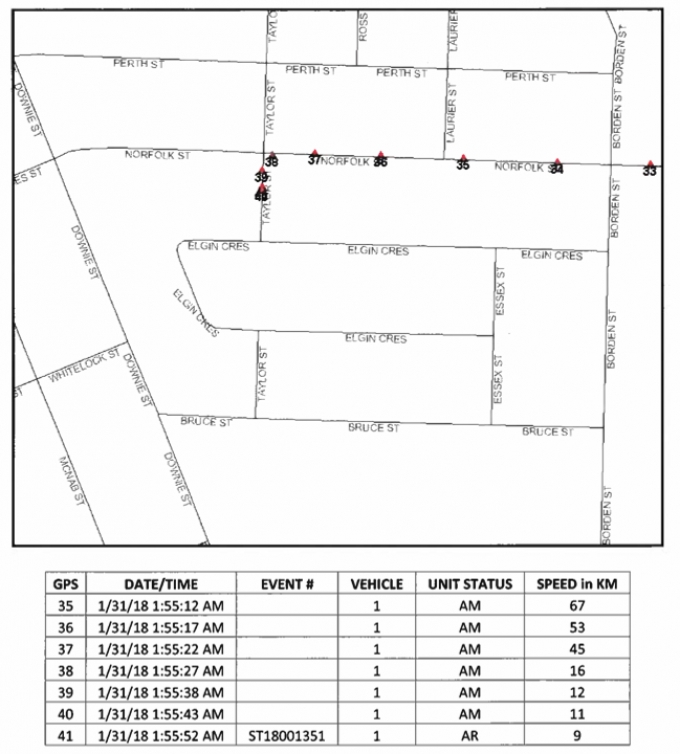
Pre-Crash Data Retrieval from Jeep Compass
Data recorded from five seconds prior to collision (-5.0) to immediately prior to point of impact with tree at -0.1 seconds.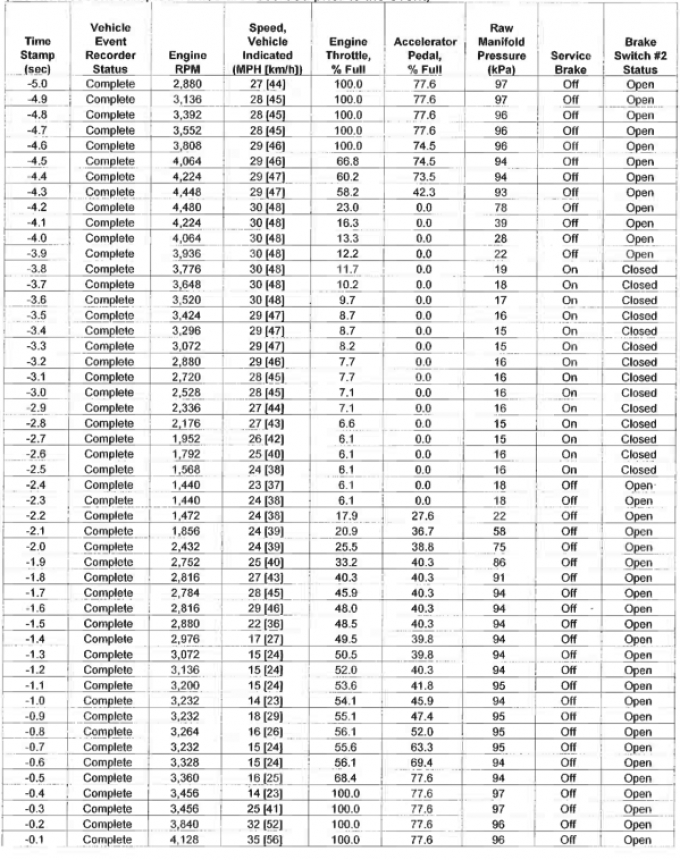
Video/Audio/Photographic Evidence
The SIU canvassed the area for any video or audio recordings, and photographic evidence, but none were located.Communications Recordings
The police transmissions communications recording was obtained and reviewed.Forensic Evidence
No submissions were made to the Centre of Forensic Sciences.Materials obtained from Police Service
Upon request, the SIU obtained and reviewed the following materials and documents from the SPS:- Computer Aided Dispatch (CAD) Details;
- Police Transmissions Communications Recording;
- Crown Brief Synopsis;
- Event Details Report;
- Fail to Stop Report;
- General Report;
- GPS Data for the SO’s police vehicle;
- List of Involved Officers;
- Motor Vehicle Collision Report;
- SPS Collision Scene Photos
- Notes of WO #1 and the SO; and,
- Procedure: Suspect Apprehension Pursuits.
The SIU obtained and reviewed the following materials and documents from other sources:
- Medical Records of Complainant #s 1 and 2, related to this incident; and
- Crash Data Retrieval from the Jeep Compass.
Relevant Legislation
Sections 1-3, Ontario Regulation 266/10, Ontario Police Services Act -- Suspect Apprehension Pursuits
1. (1) For the purposes of this Regulation, a suspect apprehension pursuit occurs when a police officer attempts to direct the driver of a motor vehicle to stop, the driver refuses to obey the officer and the officer pursues in a motor vehicle for the purpose of stopping the fleeing motor vehicle or identifying the fleeing motor vehicle or an individual in the fleeing motor vehicle.
(2) A suspect apprehension pursuit is discontinued when police officers are no longer pursuing a fleeing motor vehicle for the purpose of stopping the fleeing motor vehicle or identifying the fleeing motor vehicle or an individual in the fleeing motor vehicle.
2. (1) A police officer may pursue, or continue to pursue, a fleeing motor vehicle that fails to stop,
(a) if the police officer has reason to believe that a criminal offence has been committed or is about to be committed; or(b) for the purposes of motor vehicle identification or the identification of an individual in the vehicle.
(2) Before initiating a suspect apprehension pursuit, a police officer shall determine that there are no alternatives available as set out in the written procedures of,
(a) the police force of the officer established under subsection 6 (1), if the officer is a member of an Ontario police force as defined in the Interprovincial Policing Act, 2009;(b) a police force whose local commander was notified of the appointment of the officer under subsection 6 (1) of the Interprovincial Policing Act, 2009, if the officer was appointed under Part II of that Act; or(c) the local police force of the local commander who appointed the officer under subsection 15 (1) of the Interprovincial Policing Act, 2009, if the officer was appointed under Part III of that Act.
(3) A police officer shall, before initiating a suspect apprehension pursuit, determine whether in order to protect public safety the immediate need to apprehend an individual in the fleeing motor vehicle or the need to identify the fleeing motor vehicle or an individual in the fleeing motor vehicle outweighs the risk to public safety that may result from the pursuit.
(4) During a suspect apprehension pursuit, a police officer shall continually reassess the determination made under subsection (3) and shall discontinue the pursuit when the risk to public safety that may result from the pursuit outweighs the risk to public safety that may result if an individual in the fleeing motor vehicle is not immediately apprehended or if the fleeing motor vehicle or an individual in the fleeing motor vehicle is not identified.
(5) No police officer shall initiate a suspect apprehension pursuit for a non-criminal offence if the identity of an individual in the fleeing motor vehicle is known.
(6) A police officer engaging in a suspect apprehension pursuit for a non-criminal offence shall discontinue the pursuit once the fleeing motor vehicle or an individual in the fleeing motor vehicle is identified.
3. (1) A police officer shall notify a dispatcher when the officer initiates a suspect apprehension pursuit.
(2) The dispatcher shall notify a communications supervisor or road supervisor, if a supervisor is available, that a suspect apprehension pursuit has been initiated
Section 249, Criminal Code -- Dangerous operation of motor vehicles, vessels and aircraft
249 (1) Every one commits an offence who operates
(a) a motor vehicle in a manner that is dangerous to the public, having regard to all the circumstances, including the nature, condition and use of the place at which the motor vehicle is being operated and the amount of traffic that at the time is or might reasonably be expected to be at that place(3) Every one who commits an offence under subsection (1) and thereby causes bodily harm to any other person is guilty of an indictable offence and liable to imprisonment for a term not exceeding ten years.
Section 219 and 221, Criminal Code -- Criminal negligence causing bodily harm
219 (1) Every one is criminally negligent who
(a) in doing anything, or(b) in omitting to do anything that it is his duty to do,
shows wanton or reckless disregard for the lives or safety of other persons.
(2) For the purposes of this section, duty means a duty imposed by law.
Analysis and Director's Decision
The events in question leading to Complainant #2’s fractured ankles and Complainant #1’s bruised kidney are clear on the evidence collected by the SIU, which included statements from Complainant #2 and Complainant #1, the SO, CW #1, the driver of the vehicle in which Complainant #2 and Complainant #1 were travelling, and both the GPS/AVL data from the subject officer’s police vehicle and the crash data retrieval from the Jeep Compass.
On January 31, 2018, the SO was dealing with an unrelated vehicle stop, when he was notified to attend the area of Romeo Street in the City of Stratford to investigate an unrelated matter. The SO, upon arriving on Romeo Street, observed a Jeep Compass motor vehicle driving without its taillights illuminated. The SO accelerated his police vehicle in order to catch up to the Jeep and inform the driver that he may have inadvertently failed to turn on the full lighting system.
As the SO neared the Jeep Compass, on Norfolk Street in the area of Laurier Street, he activated his emergency lighting system in order to alert the driver of the Jeep that he was conducting a vehicle stop. Within a second or less of activating his emergency lighting system, the driver of the Jeep, CW #1, accelerated and then attempted to negotiate a left turn onto Taylor Street, losing control of his vehicle, mounting the curb on Taylor Street, crossing over the sidewalk and striking a tree, where the Jeep came to rest. CW #1 then fled from the vehicle, leaving behind his three passengers.
The evidence of the SO that he only activated his emergency lighting system after the intersection of Norfolk Street and Laurier Street, some six to seven houses before the intersection of Norfolk and Taylor Streets, is consistent with the evidence of the occupants of the Jeep Compass. Complainant #1 indicated that as soon as she observed that a police vehicle was behind their vehicle, with his emergency lighting but no siren activated, CW #1 sped up, lost control, and hit the tree. Complainant #1 estimated the distance between her seeing the police car with its emergency lighting activated, and CW #1 striking the tree, was approximately the length of four residential homes and a period of approximately seven seconds. Similarly, Complainant #2 indicated that immediately after she observed the police car, with emergency lighting activated, behind them, CW #1 accelerated and drove directly into a tree while attempting a left turn, with CW #1indicating that he estimated the distance that he travelled after seeing the police car and before he struck the tree, as being only some six feet.
Furthermore, CW #1 opined that he lost control of his motor vehicle not due to any actions by the SO, but rather due to the recent snowfall which had accumulated on the roadway.
The GPS/AVL data from the SO’s police vehicle further confirmed not only that the time that both vehicles travelled forward, after he activated his emergency lighting system, was only, at most, 15 seconds (from point 36 to point 38 on the AVL chart), but far more likely five seconds (from point 36 to point 37 on the AVL chart) but also that after the SO activated his emergency lighting system, rather than accelerating to catch up to the Jeep Compass, the police cruiser was slowed from 53 and then to 45 km/h, decelerating even further then to 16, 12, 11, and then 9 km/h, presumably as a result of the Jeep colliding with the tree.
On this record, it is clear that at the time that CW #1 crashed his motor vehicle into the tree on Taylor Street, he was not being pursued by the SO. In fact, as soon as the SO observed that the Jeep Compass was not going to stop, but instead was accelerating away from the police vehicle, rather than initiate a pursuit, the SO slowed his police vehicle. Notwithstanding the actions of the SO, however, CW #1, in his efforts to flee from the police, took the left turn at an apparently unsafe speed and in less than ideal road and weather conditions, and crashed his vehicle.
In conclusion, while the SO was acting completely within his lawful duties when he activated his emergency lighting system to alert CW #1 to pull over in order that he could advise him that he had failed to activate the full lighting system on his vehicle, the actions of CW #1 in accelerating and taking a left turn too quickly thereby causing the single vehicle collision, were unforeseeable and there is no causal connection between the actions of the SO and the subsequent collision and consequent injuries. It is clear on the evidence that at no time did the SO engage the Jeep Compass in a vehicular pursuit, and that the SO’s response to the fleeing motor vehicle fell well within the limits of the criminal law, and there is no basis whatsoever for proceeding with criminal charges against the subject officer in this case, and the file is closed.
Date: November 16, 2018
Original signed by
Tony Loparco
Director
Special Investigations Unit
On January 31, 2018, the SO was dealing with an unrelated vehicle stop, when he was notified to attend the area of Romeo Street in the City of Stratford to investigate an unrelated matter. The SO, upon arriving on Romeo Street, observed a Jeep Compass motor vehicle driving without its taillights illuminated. The SO accelerated his police vehicle in order to catch up to the Jeep and inform the driver that he may have inadvertently failed to turn on the full lighting system.
As the SO neared the Jeep Compass, on Norfolk Street in the area of Laurier Street, he activated his emergency lighting system in order to alert the driver of the Jeep that he was conducting a vehicle stop. Within a second or less of activating his emergency lighting system, the driver of the Jeep, CW #1, accelerated and then attempted to negotiate a left turn onto Taylor Street, losing control of his vehicle, mounting the curb on Taylor Street, crossing over the sidewalk and striking a tree, where the Jeep came to rest. CW #1 then fled from the vehicle, leaving behind his three passengers.
The evidence of the SO that he only activated his emergency lighting system after the intersection of Norfolk Street and Laurier Street, some six to seven houses before the intersection of Norfolk and Taylor Streets, is consistent with the evidence of the occupants of the Jeep Compass. Complainant #1 indicated that as soon as she observed that a police vehicle was behind their vehicle, with his emergency lighting but no siren activated, CW #1 sped up, lost control, and hit the tree. Complainant #1 estimated the distance between her seeing the police car with its emergency lighting activated, and CW #1 striking the tree, was approximately the length of four residential homes and a period of approximately seven seconds. Similarly, Complainant #2 indicated that immediately after she observed the police car, with emergency lighting activated, behind them, CW #1 accelerated and drove directly into a tree while attempting a left turn, with CW #1indicating that he estimated the distance that he travelled after seeing the police car and before he struck the tree, as being only some six feet.
Furthermore, CW #1 opined that he lost control of his motor vehicle not due to any actions by the SO, but rather due to the recent snowfall which had accumulated on the roadway.
The GPS/AVL data from the SO’s police vehicle further confirmed not only that the time that both vehicles travelled forward, after he activated his emergency lighting system, was only, at most, 15 seconds (from point 36 to point 38 on the AVL chart), but far more likely five seconds (from point 36 to point 37 on the AVL chart) but also that after the SO activated his emergency lighting system, rather than accelerating to catch up to the Jeep Compass, the police cruiser was slowed from 53 and then to 45 km/h, decelerating even further then to 16, 12, 11, and then 9 km/h, presumably as a result of the Jeep colliding with the tree.
On this record, it is clear that at the time that CW #1 crashed his motor vehicle into the tree on Taylor Street, he was not being pursued by the SO. In fact, as soon as the SO observed that the Jeep Compass was not going to stop, but instead was accelerating away from the police vehicle, rather than initiate a pursuit, the SO slowed his police vehicle. Notwithstanding the actions of the SO, however, CW #1, in his efforts to flee from the police, took the left turn at an apparently unsafe speed and in less than ideal road and weather conditions, and crashed his vehicle.
In conclusion, while the SO was acting completely within his lawful duties when he activated his emergency lighting system to alert CW #1 to pull over in order that he could advise him that he had failed to activate the full lighting system on his vehicle, the actions of CW #1 in accelerating and taking a left turn too quickly thereby causing the single vehicle collision, were unforeseeable and there is no causal connection between the actions of the SO and the subsequent collision and consequent injuries. It is clear on the evidence that at no time did the SO engage the Jeep Compass in a vehicular pursuit, and that the SO’s response to the fleeing motor vehicle fell well within the limits of the criminal law, and there is no basis whatsoever for proceeding with criminal charges against the subject officer in this case, and the file is closed.
Date: November 16, 2018
Original signed by
Tony Loparco
Director
Special Investigations Unit
Note:
The signed English original report is authoritative, and any discrepancy between that report and the French and English online versions should be resolved in favour of the original English report.
